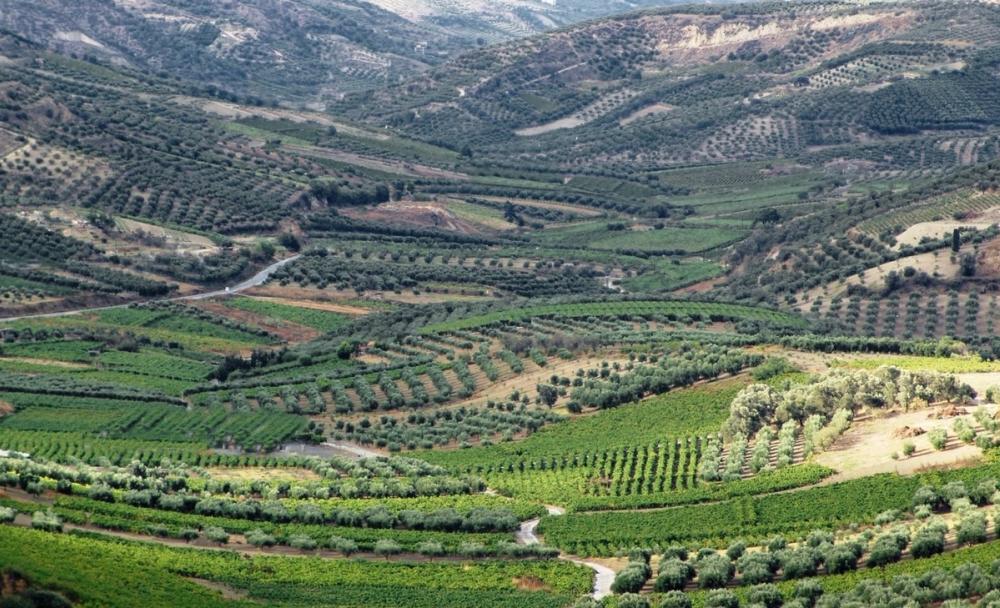Justin Keay joins a special Zoom tasting of Crete wines that was held to showcase the island’s diversity and unique grape varieties hosted by Demetri Waters MW.
Greek wine is unmistakably on a roll right now. With drinkers increasingly focused on authenticity and on where their wine comes from, the on and off-trade have seen sales rocket. It’s not hard to understand why.
Greece is blessed with a fascinating range of autochthonous grape varieties, has a close association, for many people, with holidays and good times, and has benefited from recent changes in winemaking techniques which have boosted quality.
The charge was led by Santorini and Assyrtiko (loved for its acidity and volcanic minerality); it was carried forward by the Peloponnese/Nemea (full bodied reds made from Agiorgitiko and fresh fruity whites from Moschofilero) whilst further north Naoussa’s historic variety Xinomavro (regarded as Greece’s Nebbiolo) has been receiving growing international recognition.

Crete has huge potential and a wide variety of unique grape varieties all waiting to be discovered, says Justin Keay
But what of Crete? Despite a long tradition of winemaking that dates back to the Minoan era, and some appealing varieties, the fifth biggest island in the Mediterranean – and Greece’s biggest – has seemingly been an also ran in Greece’s viticultural renaissance.
Historic factors contrived to hold Crete back. It was the last part of Greece to remain under Ottoman control – until 1913 – which meant a modern wine drinking culture took longer to develop here; in the 1970s, it was hit – rather belatedly- by phylloxera although the impact of this was slowed by the widespread presence of sandy soil. Meanwhile the rapid development of tourism in the 1970s and 1980s saw producers focus on volume, ignoring the island’s rich heritage of some 35 autochthonous varieties. And quality producers wanting to distance themselves from those who did grow local varieties (but badly) planted international varieties like Syrah and Cabernet Sauvignon. Meanwhile a lot of grapes go into Tsikoudia, the island’s answer to raki.
Changing fast
But things are changing, fast. Several of the 60 producers operating here have been working to revive old local varieties, including Lyrarakis – which curates a nursery of local varieties at its winery – Daloufakis and Idaia, all based in the main wine-growing region near the capital, Heraklion, rescuing some from near extinction.

Steve Daniel, who has a home in Santorini, has long been a supporter, buyer and importer of Greek wines
Steve Daniel, chief wine buyer for Hallagarten & Novum Wines, which imports a wide range of Greek wines, including Idaia from Crete, says Crete’s reputation lagged the rest of Greece by 10 years but is now making up for lost time.
“Now they have well and truly caught up – particularly the whites,” he says, adding: “Crete has grape varieties that nowhere else on Earth has. It has altitude and it has great limestone soils. This is a fantastic combination that given the island such unique characteristics.”
For their part, importers have been taking notice too, with Majestic, various independents and many on-trade agencies following Hallgarten and importing Cretan wine. I realised something fundamental had changed in awareness of the island’s wine profile when a Cretan red – a Liatiko – featured amongst the top wines being offered at the Foodies Festival in Winchester this July – that would have been hard to imagine even a year or two ago.
Demetri Walters MW dates the start of Crete’s wine renaissance to the 1990s but says things moved forward particularly in the past few years, driven by those original producers but also by new ones, who are focusing on historic varieties but also exploring new styles, including amber and rose wines.
Proof in the glass
To help bolster recognition in the UK trade, Walters held a Zoom class exploring Crete’s key varieties through eight very different wines from across the island.
First off, Vidiano, probably Crete’s best known white variety. This example was surprisingly full bodied, single vineyard, resting on its lees for three months before going into stainless steel. Quite a lot going on here, with high acidity framing the fruit. This would work well with food but also as an aperitif. This variety is very textural and drought tolerant – handy for Crete – and also adaptable; later in the Zoom tasting we met it again but as an orange wine, the skin contact bringing about a well made aperitif wine, very clean and with a lot of character.

The best is yet to come from Crete
The next two whites couldn’t have been more different. Roumeiko is something of a rarity here in that it is a red variety that can be made into red, pink or, as here, white wine, albeit with a slightly pink/orange tinge. An ancient variety native to western Crete, around Chania, the island’s second city, it is often made into Marouvas, a homemade drink resembling sherry. But in the right hands, as here, it makes a delicious wine, not unlike a Viognier, with low acidity but lots of fruit.
Thrapsathiri, from which our next wine was made, was different again. Generally grown in the centre of Crete, it is closely related to Vidiano, with which it used to often be blended. Drought resistant, it is also late ripening; our example showed low to moderate acidity, melon and peach dominant amidst quite a broad palette of flavours. Other wines made from this very aromatic variety demonstrate a definite and characteristic salinity supporting the fruit.
Red varieties
Moving onto the reds varieties, Liatiko featured as a surprisingly full bodied red and a fragrant, rounded rose. Walters says the variety has a long heritage.
“Grape residues from this can be dated back to the third century BC. This is a very adaptable variety; although it has modest tannins, it also has a lot of presence and amazing phenolic grip,” he says.
On the palate, with both the pink and red Liatiko, what was most apparent was bitter cherry, supported by black current and bay leaf. Other Liatiko’s can have a very different (lighter) weight and flavour profile, and much lower alcohol, suggesting this is the most versatile of Crete’s red varieties.
Walters suggested the next two wines – both single vineyard – were very different – and he was right. The first showcased Kotsifali – which translates as blackbird because these animals love variety’s big black grapes – and Mandilari, quite a common blend in Crete. The first variety rarely appears on its own because it carries a lot of sugar, has low tannins and low acidity – all of which makes it the ideal blending partner for Mandilari, a variety widely planted around Crete and indeed the eastern Aegean.
The Kotsifali-Mandilari was medium strength, around 12.5% alcohol, with good grip and the unmistakable taste of sour cherries. The Mandilari, by contrast, was fuller but with good acidity and balance, and quite intense too, having spent some 12 months in oak. The alcohol here was much higher too, some 14%.

Plyto is another of Crete’s “outstanding” varieties says Justin Keay
It’s worth noting that extensive though this tasting was, it missed quite a few of Crete’s other outstanding varieties, including the intensely herbal Dafni and Plyto varieties and Vilana, the island’s most widely planted white variety which can produce light, quite citric wines but which can also be something of a workhorse variety. Malvasia di Candida and Muscat of Spinas are also grown here in increasing quantities, to make aromatic and floral whites.
Observers say that in many ways the best is yet to come. Steve Daniel says producers still need to work with the red varieties to realise the island’s full potential in red wines, but remains confident this will happen.
“Crete has a great future and is now moving very quickly to being a key player in the Greek winemaking scene. There are more and more quality producers emerging and they should be able to offer some great value for money interesting wines in the years to come,” he argues.
So expect to see more Cretan wines – made from great varieties with diversity and character, exactly what the contemporary UK wine drinker wants – coming our way, soon.
































